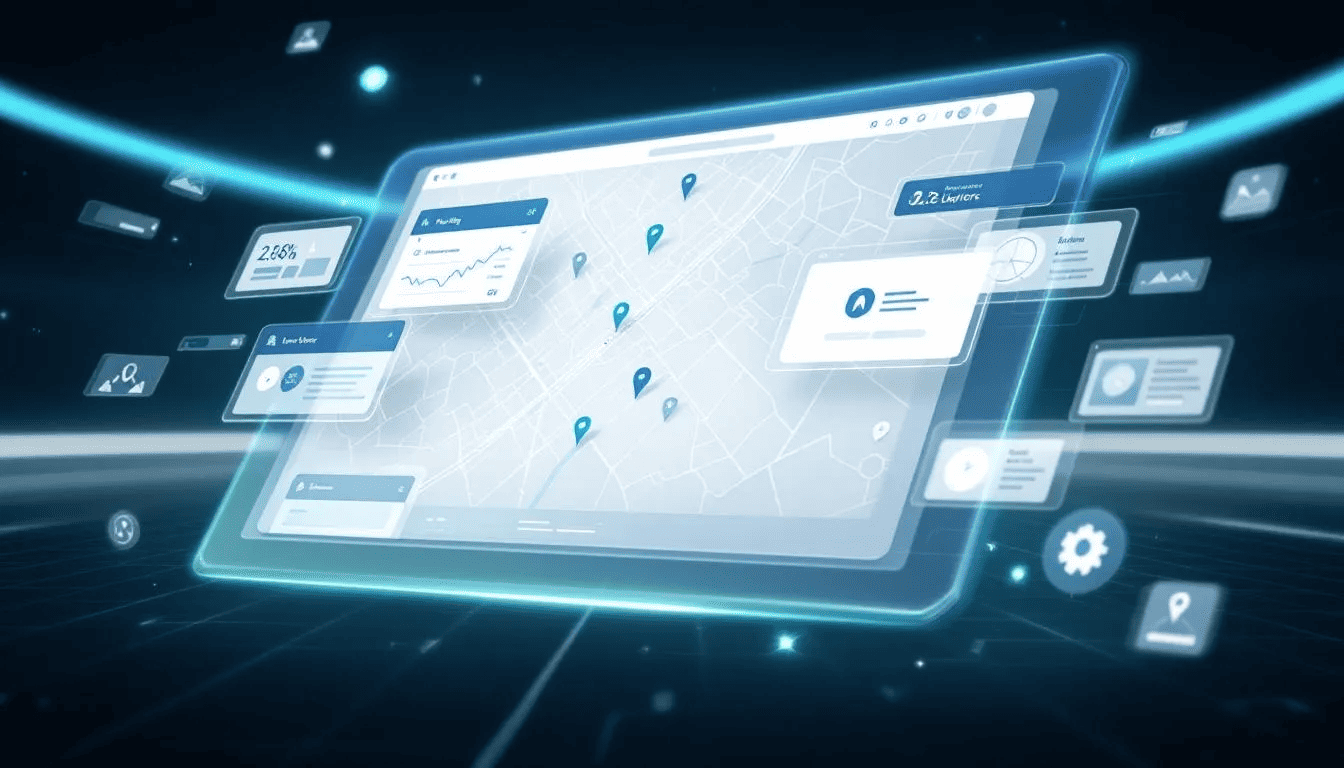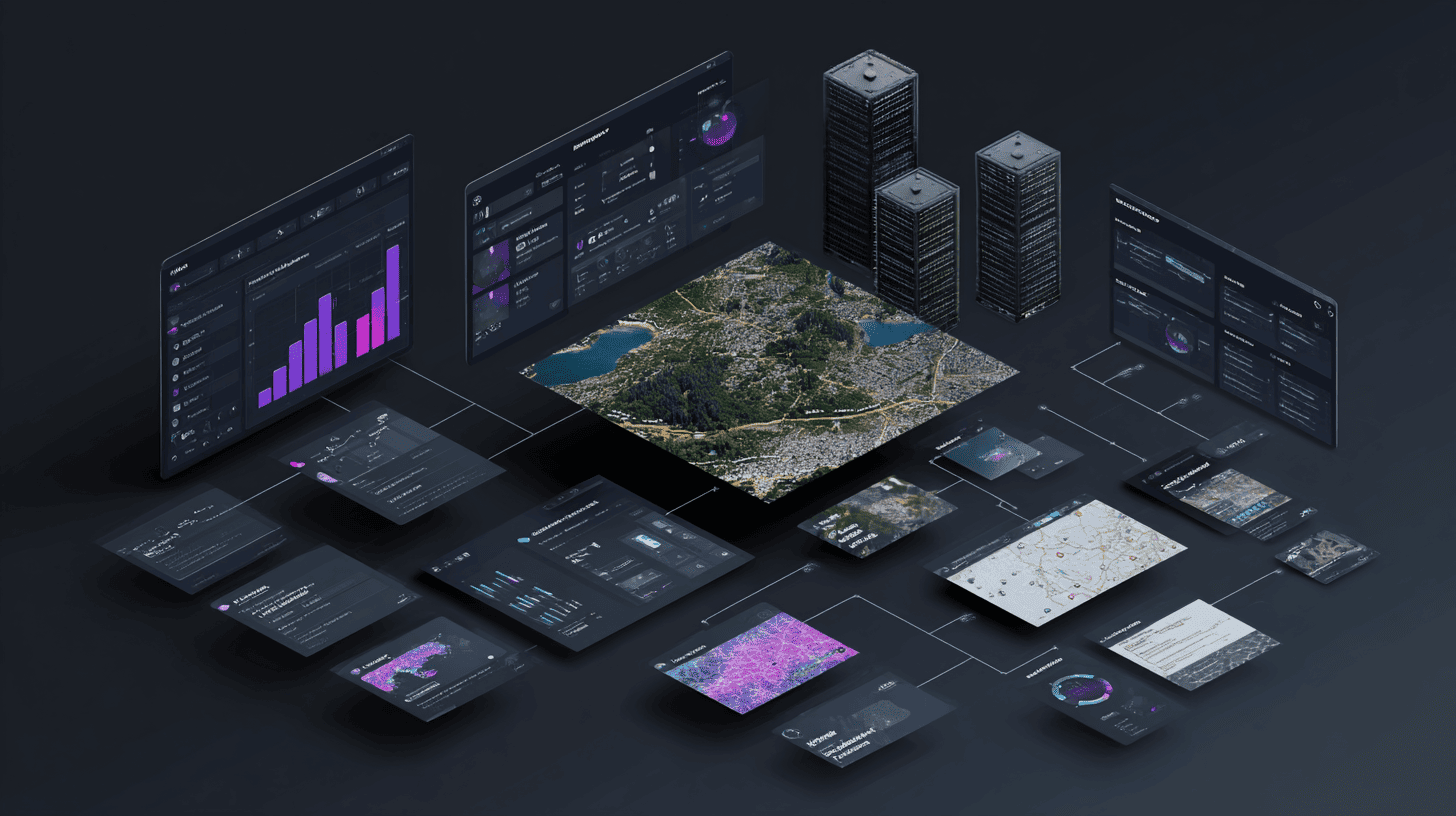Mapbox Enterprise Solutions: From API Integration to Custom Platforms
Alexander Stasiak
Oct 01, 2025・15 min read
Table of Content
Key Takeaways
Why Enterprises Choose Mapbox
Understanding the Power of Mapbox for Enterprise Mapping Needs
Unpacking Mapbox Features for Businesses
Cost Efficiency and Flexibility
Scalable API Integration for Large Applications
Security and Compliance Considerations
Setting Up Your Mapbox Environment
Core Components of Mapbox Enterprise Integration
Customizing Maps for Enterprise Needs
Creating Custom Markers and Layers
Enhancing User Experience with Personalized Maps
Styling Maps with Mapbox Studio
Real-Time Data Handling and Visualization
Optimizing Performance for Large Datasets
Enhancing Interactivity with Mapbox GL JS
Ensuring Data Security and Compliance
Post-Launch Support and Maintenance
Case Studies: Successful Enterprise Integrations
Choosing the Right Mapbox Integration Partner
Finding and Collaborating with Top Mapbox API Partners
Conclusion
Summary
Frequently Asked Questions
What are the benefits of using Mapbox for enterprise mapping needs?
How does Mapbox ensure data security and compliance?
What is the importance of choosing the right Mapbox integration partner?
How can businesses enhance user experience with Mapbox?
What are the core components of Mapbox enterprise integration?
Build Your Custom Mapbox Integration with Experts
Unlock the full potential of Mapbox for your business.👇
Looking to integrate sophisticated mapping solutions into your enterprise systems? Mapbox enterprise integration offers unparalleled customization and scalability to meet your unique business needs. In this guide, we’ll explore how integrating Mapbox can boost operational efficiency, provide real-time data insights, and enhance user experiences. Discover the steps, features, and benefits of leveraging Mapbox for your enterprise.
Key Takeaways
- Mapbox stands out for its extensive customization capabilities, allowing enterprises to create tailored mapping solutions that enhance functionality and branding.
- The platform’s flexible pricing models and scalability make it cost-effective for businesses of all sizes, ensuring efficient budget management and high returns on investment.
- Mapbox’s commitment to security and compliance, along with ongoing support and maintenance, enables enterprises to confidently integrate and utilize mapping solutions without compromising data privacy.
Why Enterprises Choose Mapbox

The growing demand for sophisticated mapping solutions leads businesses to choose between leading platforms, with Mapbox and Google Maps often being the top contenders. However, Mapbox differentiates itself by offering extensive customization options that cater to the unique mapping needs of enterprises. This flexibility significantly contributes to Mapbox being the preferred choice for many businesses.
Mapbox maps provide enterprises with the ability to create highly interactive and customizable maps that can be tailored to specific requirements. This level of customization is not just about aesthetics; it extends to functionality, allowing businesses to integrate maps seamlessly into their applications and systems. For logistics, real estate, or travel, Mapbox’s mapping solutions offer features that enhance operational efficiency and user experience.
Moreover, the cost efficiency and flexibility of Mapbox make it an attractive option for enterprises. Unlike other mapping solutions, Mapbox offers pricing plans that can be tailored to the scale and scope of the project. This ensures that businesses can manage their budgets effectively while still benefiting from advanced mapping capabilities.
Next, we delve into the power of Mapbox for enterprise mapping needs.
Understanding the Power of Mapbox for Enterprise Mapping Needs
Mapbox API delivers robust, detailed, and interactive mapping solutions that are essential for modern enterprises. The platform is designed to meet the unique needs of businesses, providing extensive customization capabilities that allow companies to create maps that align with their functional and branding demands. Such customization is vital for enterprises needing specific mapping functionalities beyond standard offerings.
The scalability of Mapbox is another key advantage. As businesses grow and their mapping needs evolve, Mapbox can effortlessly scale to support an increasing number of users and data points. This ensures that enterprises can continue to rely on Mapbox as their operations expand, without worrying about performance limitations.
Integration of real-time geographic data into mapping applications significantly enhances business decision-making. By providing real-time access to location data, Mapbox enables businesses to make informed decisions quickly, improving operational efficiency and customer satisfaction. These capabilities make Mapbox a powerful tool for enterprises looking to leverage geospatial data for competitive advantage.
Unpacking Mapbox Features for Businesses
Mapbox maps are renowned for dynamic visualizations and interactive features that captivate users. The platform allows businesses to create visually engaging presentations of their data, making it suitable for various applications. The ability to create interactive maps that users can engage with enhances the overall user experience and drives higher levels of engagement.
Integrating Mapbox with enterprise tools and systems is seamless. The platform’s APIs are designed to work effortlessly with existing enterprise software, enabling businesses to integrate maps into their applications without significant overhead. Moreover, Mapbox offers advanced analytics that provide insights into user behavior and map performance, helping businesses make data-driven decisions.
Location services offered by Mapbox services enhance operational efficiency by providing accurate and up-to-date location data. These location based services are essential for businesses that rely on precise location information for their operations, such as logistics and transportation companies. High-quality visuals, easy integration, and advanced analytics make Mapbox an invaluable location platform for enterprises.
Cost Efficiency and Flexibility
One of the standout features of Mapbox is its flexible pricing models that are well-suited for enterprises. Whether a business is just starting with small-scale applications or requires high-volume usage scenarios, Mapbox’s pricing structure can accommodate varying needs, including volume discounts. This flexibility ensures that enterprises can manage their mapping costs effectively, enhancing overall budget management.
Mapbox’s scalable usage model contributes to cost efficiency in several ways:
- It allows businesses to pay only for what they use through a pay-as-you-go pricing model.
- This pricing model adjusts costs based on usage, reducing unnecessary expenses and providing high returns on investment.
- The flexible APIs offered by Mapbox reduce development time and costs, further enhancing the overall value proposition.
The high return on investment made possible by Mapbox’s efficient integration and flexible pricing models is a significant advantage for enterprises. By minimizing development time and maximizing cost efficiency, Mapbox enables businesses to focus on innovation and growth while maintaining control over their budgets.
Next, we explore achieving scalable API integration for large applications using Mapbox.
Scalable API Integration for Large Applications

Integrating Mapbox API into business applications is a straightforward process that offers numerous benefits. The comprehensive suite of Mapbox APIs allows businesses to integrate maps seamlessly into their web and mobile applications, providing a consistent user experience across multiple platforms. This integration is essential for location-based applications that require accurate and up-to-date mapping data.
Achieving seamless Mapbox API integration involves a few essential steps:
- Create a Mapbox account and obtain the necessary access tokens to use the APIs.
- Configure the APIs to match specific requirements, tailoring the maps to their needs.
- Test the integration thoroughly to ensure that it functions correctly across all devices and platforms.
Using Mapbox APIs across multiple platforms offers several advantages, including extensive customization options and the ability to handle large volumes of data through efficient API calls. This flexibility allows businesses to create highly customizable and scalable mapping solutions that meet their unique requirements.
Next, we discuss the security and compliance considerations for enterprises using Mapbox.
Security and Compliance Considerations
Security and compliance are critical considerations for any enterprise using mapping solutions. Mapbox employs robust data encryption protocols to secure data both in transit and at rest. This ensures that sensitive information is protected from unauthorized access, providing peace of mind for businesses and their customers.
Mapbox is fully compliant with industry standards such as GDPR and CCPA, ensuring that it meets the stringent data protection requirements of various regions. Regular audits and updates are conducted to maintain the highest levels of security and compliance. By adhering to these standards, Mapbox ensures that businesses can confidently use its services without compromising on data privacy and security.
Setting Up Your Mapbox Environment

Setting up a Mapbox environment is the initial step to accessing its powerful tools and APIs. To get started, businesses need to create a Mapbox account, which provides a default public token for quick initial use. This token allows users to start experimenting with Mapbox’s features immediately.
Access tokens are crucial for using Mapbox tools, APIs, or SDKs. These tokens are categorized into public and secret tokens, each with specific permissions known as scopes. Public tokens provide limited permissions primarily for read access, while secret tokens allow full access to Mapbox resources and must be kept secure to prevent unauthorized use.
To enhance security, businesses can:
- Track the use statistics for all tokens on the Mapbox account’s Statistics page.
- Add URL restrictions to limit token usage to specified domains.
- Set permissions appropriately.
- Enable two-factor authentication to ensure the integrity of the Mapbox environment.
Following these steps ensures a secure and efficient Mapbox setup when properly set.
Core Components of Mapbox Enterprise Integration

Mapbox provides a range of tools and APIs critical for enterprise solutions. One of the key components is the geocoding APIs, which are available in two forms: a Temporary API for single requests that cannot be stored, and a Permanent API for requests that can be saved. The Temporary Geocoding API allows up to 100,000 free requests per month, while the Permanent API offers more flexibility but comes with a cost.
The requirements and restrictions for using geocoding results are:
- Results from the Temporary Geocoding API must be displayed immediately and cannot be cached or reused.
- Mapbox geocoding results must be displayed on a Mapbox map and cannot be used with other mapping platforms.
- Geocoding results cannot be used for lead generation, advertiser targeting, or advertising analysis.
Another essential tool is the Directions API, which provides real-time routing for driving, cycling, or walking, including distance, duration, and turn-by-turn instructions. This API is crucial for navigation functionalities and offers the ability to optimize routes for various applications.
Leveraging these core components, businesses can create comprehensive mapping solutions tailored to their needs.
Customizing Maps for Enterprise Needs

Customization is central to Mapbox’s offerings, enabling enterprises to create maps that meet unique requirements and branding needs. Mapbox Studio is a powerful tool that enables extensive customization options tailored for specific applications. With Mapbox Studio, businesses can create advanced map styles and tools that align with their corporate identity.
Utilizing the customization capabilities of Mapbox Studio allows enterprises to create visually appealing and functionally effective maps. Whether it’s for enhancing user experience or providing specific data insights, customized maps play a crucial role in achieving business objectives.
In the following subsections, we will explore how to create custom markers and layers, enhance user experience with personalized maps, and style maps using Mapbox Studio.
Creating Custom Markers and Layers
Custom markers can be added to maps using HTML and CSS to enhance visual communication. These markers are HTML elements that can be customized and positioned independently of the map’s data source. This flexibility allows businesses to create unique markers that fit their specific needs and branding.
Layers, on the other hand, require a data source to define point data on the map, allowing for collective updates and style management. Creating symbol, circle, fill, and data layers enhances mapping capabilities and provides detailed visualizations.
The integration of custom markers and layers improves both the visual and functional aspects of maps, including advanced features and zoom level. This enables businesses to create maps that are not only visually appealing but also highly informative and user-friendly.
Next, we discuss enhancing user experience with personalized maps.
Enhancing User Experience with Personalized Maps
Personalized maps drive user engagement by providing a tailored experience that reflects the user’s needs and preferences. By leveraging location data, businesses can create custom maps that offer relevant and personalized information to users. This can significantly enhance the user experience and increase interaction with the map.
Custom map styles reflecting brand identity further enhance user experience. Mapbox allows businesses to create map styles that align with their branding guidelines, ensuring a consistent look and feel across all touchpoints. This not only reinforces brand identity but also creates a cohesive user experience.
Real-time updates and interactive features across devices are crucial for maintaining user engagement in web applications. By providing real-time data and interactive elements, businesses can ensure that their maps are always up-to-date and relevant. This is particularly important for applications that require accurate etas and timely information, such as logistics and transportation.
Styling Maps with Mapbox Studio
Mapbox Studio offers tools enabling businesses to create custom map styles that reflect branding and functional needs. These tools enable the creation of both Mapbox-owned and user-defined styles, providing flexibility for diverse mapping requirements. By modifying colors, labels, and other map elements, businesses can modify colors to create maps that are visually appealing and aligned with their corporate identity. Additionally, businesses can explore various map style options to enhance their visual storytelling.
Custom map styles created in Mapbox Studio can be intricately aligned with corporate branding guidelines. This ensures that all maps used by the business maintain a consistent look and feel, reinforcing the brand’s identity. The ability to customize maps to such a degree sets Mapbox apart from other mapping solutions and makes it an invaluable tool for enterprises.
Utilizing Mapbox Studio’s tools and features, businesses can create functional and visually engaging maps. This not only enhances user experience but also helps in achieving business objectives by providing relevant and personalized information to users, as a developer would appreciate.
Next, we will explore how to handle and visualize real-time data effectively using Mapbox.
Real-Time Data Handling and Visualization
Visualizing real-time data such as traffic or weather conditions is one of the standout features of Mapbox. By integrating live data, businesses can create dynamic maps that provide users with up-to-date information. This is particularly beneficial for applications that rely on timely data, such as on-demand delivery or ride-hailing services.
Mapbox provides features such as live styling, custom interactivity, and robust animation for dynamic maps. These features support decision-making by allowing users to interact with the map and access real-time information. The ability to visualize data in real-time enhances the overall user experience and provides valuable insights for businesses.
Mapbox GL JS enables dynamic map experiences that can respond to live data, making it possible to create maps that update in real-time. This not only improves user engagement but also allows businesses to provide accurate and timely information to their users. The animation capabilities of Mapbox further enhance the user experience by providing smooth transitions and visual storytelling on maps.
Next, we discuss optimizing performance when handling large datasets.
Optimizing Performance for Large Datasets
Handling large datasets efficiently is crucial for ensuring smooth performance and user experience. Mapbox’s platform is continuously updated, resulting in over 100,000 updates each day, which ensures that the data is always current and accurate. High-speed rendering allows businesses to handle vast data amounts without compromising performance.
Mapbox GL JS improves map performance by allowing for rapid rendering of detailed features. One way to optimize performance is by using separate sources for static map images and dynamic data, which improves update performance in GeoJSON. This ensures that the map can handle large volumes of data efficiently, providing a seamless user experience.
Additionally, using vector tiles reduces render, source update, and layer update times compared to GeoJSON. This optimization technique, along with removing unused features from styles, helps to speed up rendering times. Implementing these strategies ensures maps perform well even with large datasets through the vector tiles API.
Next, we will explore how to enhance interactivity using Mapbox GL JS.
Enhancing Interactivity with Mapbox GL JS
Mapbox GL JS allows developers to create highly interactive maps and an interactive map that engage users by enabling them to interact dynamically with spatial data. This interactivity is essential for applications that require user input and engagement, such as travel planners or real estate platforms. By integrating interactive elements, businesses can create maps that are not only informative but also engaging.
Integrating 3D terrain and building visualizations in maps provides richer context for data and enhances user engagement. These visualizations allow users to explore the map in greater detail, providing a more immersive experience. This is particularly useful for applications that require a detailed understanding of the spatial environment, such as city planners or architecture.
Mapbox GL JS also supports custom data handling and spatial analysis, enabling users to visualize complex datasets and perform analyses in real-time. Enhancements like interactive drawing tools and animations using plugins can significantly improve the user interface and experience. By leveraging these features, businesses can create interactive maps that provide valuable insights and enhance user engagement.
Next, we discuss ensuring data security and compliance.
Ensuring Data Security and Compliance
Data security is paramount for enterprises utilizing mapping solutions. Mapbox employs robust encryption protocols to secure data both in transit and at rest, ensuring that sensitive information is protected from unauthorized access. This commitment to security provides businesses with the confidence to use Mapbox for their critical applications.
Mapbox adheres to compliance standards such as GDPR and CCPA, ensuring that it meets the stringent data protection requirements of various regions. The platform has undergone third-party audits to ensure compliance with industry-specific regulations, providing an additional layer of trust for businesses.
Maintaining high standards of security and compliance, Mapbox ensures enterprises can use its services without compromising data privacy.
Post-Launch Support and Maintenance
Post-launch support is crucial for the long-term success of any Mapbox integration. Regular updates to the SDK are essential to maintain compatibility with the latest features and security protocols from Mapbox. These updates ensure that the mapping applications continue to perform optimally and securely.
Continuous monitoring for bugs and performance issues is also essential for keeping Mapbox integrations running smoothly. By addressing any issues promptly, businesses can maintain a high-quality user experience and avoid potential disruptions. This ongoing maintenance is a critical aspect of ensuring the longevity and success of the Mapbox integration.
User experience enhancements should be based on analytics to improve interaction with the Mapbox application over time. By analyzing user behavior and feedback, businesses can make informed decisions about how to enhance the mapping experience. This iterative process of improvement ensures that the application remains relevant and engaging for users.
Next, we look at case studies of successful enterprise integrations with Mapbox.
Case Studies: Successful Enterprise Integrations
The Weather Company leverages Mapbox to present weather forecasts visually on maps for billions of users. By integrating Mapbox’s mapping solutions, The Weather Company can provide accurate and engaging weather information, enhancing user experience and engagement.
T-Mobile utilizes Mapbox for creating and updating comprehensive coverage maps across different regions. This integration allows T-Mobile to provide detailed coverage information to its customers, improving customer satisfaction and trust. The use of Mapbox’s vector styles and boundary data enhances the visual quality and accuracy of these maps.
Tableau enhances its mapping capabilities by integrating Mapbox’s vector styles and boundary data. This integration allows Tableau to offer:
- More detailed mapping options
- Customizable mapping options
- Valuable insights
- Enhanced data visualization capabilities
These case studies highlight the transformative impact of Mapbox integrations across various industries. In the next section, we will discuss how to choose the right Mapbox integration partner.
Choosing the Right Mapbox Integration Partner
Choosing the right Mapbox integration partner is crucial for the success of any mapping project. It’s essential to evaluate the partner’s technical abilities and experience in relevant industries. This ensures that the partner has the necessary expertise to handle the specific requirements of the project.
The flexibility of the integration partner to adapt to changing project requirements is also important. A good partner acts as a strategic advisor, helping evaluate how mapping enhances the product roadmap and aligns architecture with future scaling goals. This strategic guidance is invaluable for ensuring the long-term success of the project.
Partnering with a Mapbox expert ensures faster delivery, optimized costs, and long-term scalability. Outsourcing provides faster delivery, lower costs, specialized knowledge, and maintenance-free scaling. By choosing the right partner, businesses can ensure that their Mapbox integration is successful and meets their specific needs.
Finding and Collaborating with Top Mapbox API Partners
Startup House is a top-tier partner for Mapbox integration, offering expertise and top-tier implementation. With a proven track record in delivering successful digital products, Startup House ensures that businesses get the most out of their Mapbox integrations.
Collaboration with a Mapbox API partner like Startup House enables complex customizations that meet specific business requirements. This collaboration ensures that the mapping solutions are tailored to the unique needs of the business, providing a competitive advantage in the market.
The Mapbox network provides resources and support to ensure the success of the integration. By leveraging the expertise and resources of a top-tier partner, businesses can achieve faster time-to-market and optimized costs, ensuring the long-term success of their Mapbox integration.
In conclusion, we summarize key points and highlight the benefits of Mapbox for enterprises.
Conclusion
Mapbox Enterprise offers scalable and customizable mapping solutions that are ideal for modern businesses. The platform’s security, flexibility, and performance make it enterprise-ready, ensuring that businesses can rely on it for their critical applications. Case studies validate its effectiveness, showcasing the transformative impact of Mapbox integrations across various industries.
The potential for innovation and digital transformation with Mapbox is immense. By leveraging its powerful features and tools, businesses can create interactive and engaging mapping solutions that drive user engagement and enhance operational efficiency. The combination of robust security, flexible pricing, and advanced customization options makes Mapbox a valuable asset for any enterprise looking to stay ahead in the competitive market.
In conclusion, Mapbox is an ideal platform for businesses seeking innovative solutions for their mapping needs. By partnering with a top-tier Mapbox integration partner, businesses can ensure faster delivery, optimized costs, and long-term scalability. The future of enterprise mapping is bright with Mapbox, positioning businesses for success by embracing its capabilities.
Summary
In summary, Mapbox offers a comprehensive suite of tools and APIs that cater to the unique mapping needs of enterprises. The platform’s extensive customization options, scalable usage, and real-time data integration make it a powerful tool for modern businesses. By leveraging Mapbox, businesses can create interactive and engaging maps that enhance user experience and drive operational efficiency.
Choosing the right Mapbox integration partner is crucial for the success of any mapping project. By evaluating the partner’s technical abilities, industry experience, and flexibility, businesses can ensure that their Mapbox integration is successful and meets their specific needs. Partnering with a Mapbox expert ensures faster delivery, optimized costs, and long-term scalability.
The potential for innovation and digital transformation with Mapbox is immense. By embracing its capabilities, businesses can create mapping solutions that drive user engagement and enhance operational efficiency. The future of enterprise mapping is bright with Mapbox, and businesses that leverage its capabilities will be well-positioned for success.
Frequently Asked Questions
What are the benefits of using Mapbox for enterprise mapping needs?
Using Mapbox for enterprise mapping needs provides extensive customization, scalable usage, real-time data integration, and advanced analytics, making it an effective solution for businesses seeking sophisticated mapping capabilities.
How does Mapbox ensure data security and compliance?
Mapbox ensures data security and compliance by utilizing strong encryption methods for data both in transit and at rest, while also adhering to regulations like GDPR and CCPA and undergoing regular third-party audits. This commitment to security safeguards user data effectively.
What is the importance of choosing the right Mapbox integration partner?
Choosing the right Mapbox integration partner is crucial for ensuring a successful implementation that meets your business needs, allows for faster delivery, optimizes costs, and supports long-term scalability. Making this decision carefully can significantly impact the effectiveness of your mapping solutions.
How can businesses enhance user experience with Mapbox?
Businesses can significantly enhance user experience with Mapbox by developing personalized maps that align with their brand identity through custom styles, while also integrating real-time updates and interactive features for seamless engagement across devices.
What are the core components of Mapbox enterprise integration?
The core components of Mapbox enterprise integration are geocoding APIs, the Directions API, and tools for creating custom markers and layers, allowing businesses to develop comprehensive mapping solutions effectively.
Digital Transformation Strategy for Siemens Finance
Cloud-based platform for Siemens Financial Services in Poland


You may also like...

How to Integrate Mapbox into Your React and Mobile Apps (Step-by-Step Guide)
ntegrating Mapbox into your app is one of the fastest ways to deliver powerful, customizable maps and location-based features. In this guide, you’ll learn how to set up a Mapbox account, configure access tokensand integrate the SDK.
Alexander Stasiak
Nov 18, 2025・15 min read

Mapbox vs Google Maps: Which Mapping Platform Is Better for Your App?
Choosing the right mapping platform can significantly impact your app’s success. Explore which option is the better fit for your project.
Alexander Stasiak
Nov 19, 2025・10 min read

Mapbox for Logistics: Among Top 5 Industries That Benefit Most from Mapbox Integration
Mapbox empowers industries like logistics, real estate, travel, and retail with scalable mapping solutions that enhance performance and customer satisfaction.
Alexander Stasiak
Oct 10, 2025・10 min read
Let’s build your next digital product — faster, safer, smarter.
Book a free consultationWork with a team trusted by top-tier companies.








